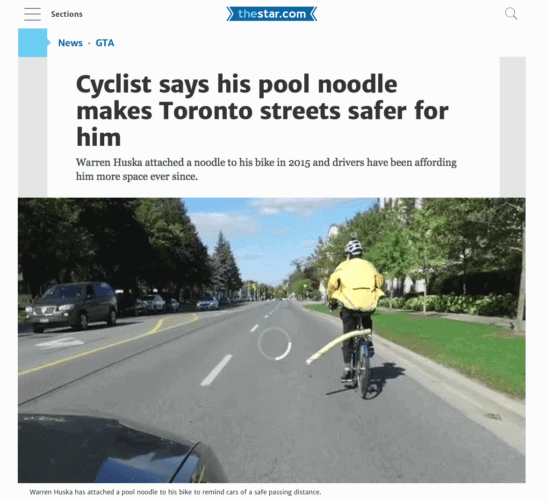This article from the Toronto Star caught my eye the other day:
Cyclist says his pool noodle makes Toronto streets safer for him
There was a law passed in Ontario requiring drivers leave one meter of space between them and cyclists. This doesn't always happen, as there have been almost 900 collisions between bikes and cars to date this year in Toronto.
It goes to show that laws (or workplace policies) are not enough to ensure safety.
So, Warren Huska attached a pool noodle to his bike as shown in the photo (and in the video, which I haven't been able to get to play on their website).
There's no evidence that Warren is a “Lean thinker” or that he has been exposed to the Lean methodology at work, but what he's done here reminds me of Lean and Kaizen (continuous improvement). What he's done is what I call a “Like Lean” practice (see more posts about this).
For one, he's “error proofing” — he's not making it impossible for a car to hit him, but he's making it more difficult probably by giving a visual signal and a barrier that a driver is more likely to see and drive around.
Error proofing is, of course, a core Lean concept for ensuring that quality is built in (rather than inspecting it in after the fact).
Secondly, he's not blaming the drivers for being bad people, as he says:
“People get really insulated inside a vehicle,” Huska said. “They don't really know where the edges of their vehicle are.”
Lean organizations and Lean leaders, including Toyota, focus first on the process and system, rather than blaming individuals. We believe that people want to do quality work and I'd assume drivers don't want to hit cyclists.
Thirdly, it's like Kaizen in that he used “creativity over capital.” A pool noodle and a bungie cord doesn't cost much and he might have already had those materials at home. Kaizen, in the workplace, is about engaging everybody in improvement, everywhere, and every day (as Masaaki Imai says).
Masaaki Imai Kaizen Video; Share Kaizen Stories for My Upcoming Book
Finally, he's putting safety first, which is definitely the top priority at Toyota or any Lean organization.
“I'm unconcerned about looking good,” Huska said. “I'm concerned about my safety most.”
The article says the practice hasn't really spread to other cyclists. I wonder why?
What do you think? Please scroll down (or click) to post a comment. Or please share the post with your thoughts on LinkedIn – and follow me or connect with me there.
Did you like this post? Make sure you don't miss a post or podcast — Subscribe to get notified about posts via email daily or weekly.
Check out my latest book, The Mistakes That Make Us: Cultivating a Culture of Learning and Innovation:











Comments from LinkedIn:
I think one of the reasons why others haven’t followed suit is because of how this looks. I know it seems irrational, but people don’t always think rationally. Malcolm Gladwell talked about this on an episode of his Revisionist History podcast focusing on Wilt Chamberlin. Chamberlin was a phenomenal basketball player with only one real weakness – free throw shooting. He refused to shoot these underhand because of how he perceived it made him look. Again, that’s not an entirely rational approach, but people aren’t always entirely rational.
Great points.
Here are some thoughts Warren shared with me via LinkedIn to add to the discussion:
Thanks for sharing your creativity, Warren. Ride safely!
A great personal safety intervention. To echo Brian’s words, I think one of the reasons why this approach is not adopted more frequently is because of how people perceive they look
In the same way people smoke. It’s rare that anyone starts because they like the taste.
Additionally, perhaps people are willing to take the risk. I cycle frequently and have probably only had the “close shave” situation twice. I’m left with my heart pumping but otherwise unscathed. I’d be more included to look for a solution if I’d ever been involved in an accident
Thanks for parsing this safety idea as a metaphor for implementing best practices in ‘error proofing’.
In my interviews, it has been notable that people drift to ‘blame’ over ‘responsibility. A core concept in urban cycling is ‘take the lane’ i.e. make it impractical for a motor vehicle to unsafely overtake in the same lane. (‘Lane’, nice kanban analogy)
The difference? I dont actually get negative feedback. i get a whole lot of ‘riiiiight, I forgot’
Cheers, Warren
Hi Warren — Thanks for commenting… it’s great to hear from you.
So you *do* have some exposure to kanban and perhaps some other Lean methodologies?
I regret not reaching out to you to ask some questions…